Typical values at TA =
+25°C, ADC Sampling Rate = 2949.12 GHz. Default conditions: output sample rate =
491.52MSPS (decimate by 6), PLL clock mode with fREF = 491.52 MHz,
AIN = –3 dBFS, DSA setting = 4 dB.
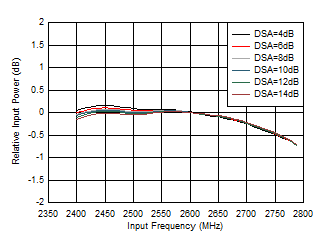
| With
matching, normalized to power at 2.6 GHz for each DSA
setting |
Figure 6-348 RX
Inband Gain Flatness, fIN = 2600 MHz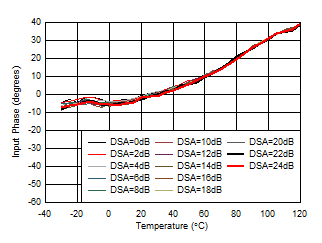
| With
2.6 GHz matching, normalized to phase at 25°C |
|
|
Figure 6-350 RX
Input Phase vs Temperature and DSA at fOUT = 2.6 GHz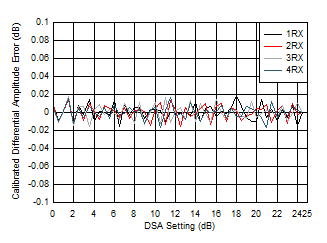
| With
2.6 GHz matching |
| Differential Amplitude Error = PIN(DSA
Setting – 1) – PIN(DSA Setting) + 1 |
Figure 6-352 RX
Calibrated Differential Amplitude Error vs DSA Setting at 2.6 GHz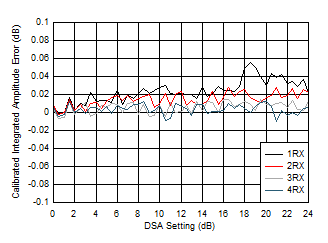
| With
2.6 GHz matching |
| Integrated Amplitude Error = PIN(DSA
Setting) – PIN(DSA Setting = 0) + (DSA
Setting) |
Figure 6-354 RX
Calibrated Integrated Amplitude Error vs DSA Setting at 2.6 GHz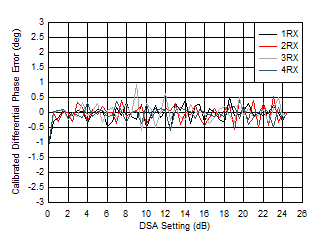
| With
2.6 GHz matching |
| Differential Phase Error = PhaseIN(DSA
Setting – 1) – PhaseIN(DSA Setting) |
Figure 6-356 RX
Calibrated Differential Phase Error vs DSA Setting at 2.6 GHz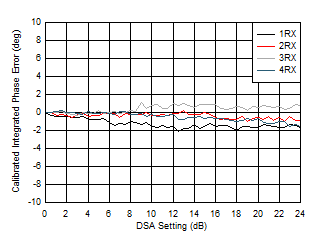
| With
2.6 GHz matching |
| Integrated Phase Error = Phase(DSA Setting) – Phase(DSA
Setting = 0) |
Figure 6-358 RX
Calibrated Integrated Phase Error vs DSA Setting at 2.6 GHz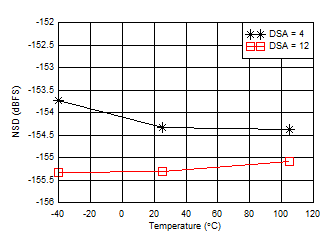
| With
2.6 GHz matching, 12.5-MHz offset from tone |
|
Figure 6-360 RX
Noise Spectral Density vs Temperature at 2.6 GHz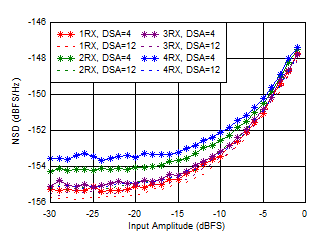
| With
2.6 GHz matching, 12.5-MHz offset from tone |
|
Figure 6-362 RX
Noise Spectral Density vs Input Amplitude and Channel at 2.6 GHz
| With
2.6 GHz matching, tone spacing = 20 MHz, DSA = 4
dB |
Figure 6-364 RX
IMD3 vs Input Level and Temperature at 2.6 GHz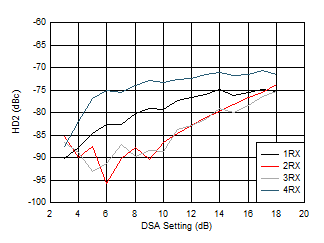
| With
2.6 GHz matching, DDC bypass mode (TI only mode for
characterization) |
Figure 6-366 RX
HD2 vs DSA Setting and Channel at 2.6 GHz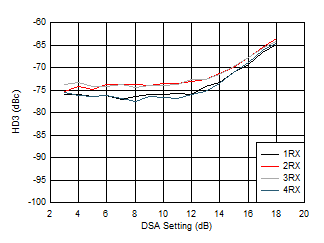
| With
2.6 GHz matching, DDC bypass mode (TI only mode for
characterization) |
Figure 6-368 RX
HD3 vs DSA Setting and Channel at 2.6 GHz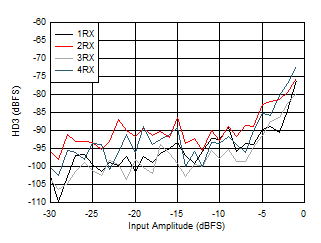
| With
2.6 GHz matching, DDC bypass mode (TI only mode for
characterization) |
Figure 6-370 RX
HD3 vs Input Level and Channel at 2.6 GHz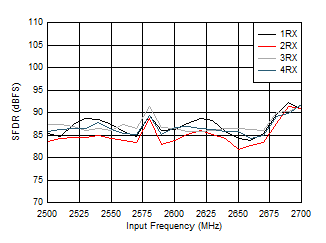 Figure 6-372 RX
In-Band SFDR (±200 MHz) vs Frequency With AIN= –1 dBFS at 2.6
GHz
Figure 6-372 RX
In-Band SFDR (±200 MHz) vs Frequency With AIN= –1 dBFS at 2.6
GHz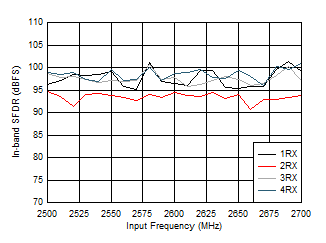 Figure 6-374 RX
In-Band SFDR (±200 MHz) vs Frequency With AIN= –12 dBFS at 2.6
GHz
Figure 6-374 RX
In-Band SFDR (±200 MHz) vs Frequency With AIN= –12 dBFS at 2.6
GHz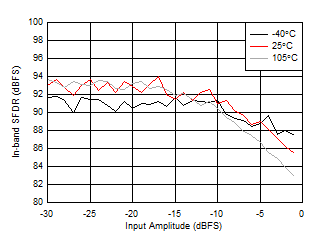 Figure 6-376 RX
In-Band SFDR (±200 MHz) vs Input Amplitude and Temperature at 2.6
GHz
Figure 6-376 RX
In-Band SFDR (±200 MHz) vs Input Amplitude and Temperature at 2.6
GHz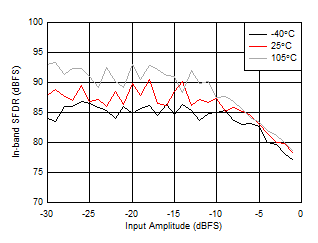
| With
2.6 GHz matching, decimate by 4 |
Figure 6-378 RX
In-Band SFDR (±300 MHz) vs Input Amplitude and Temperature at 2.6
GHz
| With
2.6 GHz matching, –7 dBFS each tone, 20-MHz tone
spacing, all supplies at MIN, TYP, or MAX recommended
operating voltages |
Figure 6-380 RX
IMD3 vs Supply and Channel at 2.6 GHz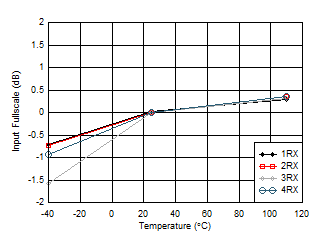
| With
2.6 GHz matching, normalized to fullscale at 25°C for
each channel |
Figure 6-349 RX
Input Fullscale vs Temperature and Channel at 2.6 GHz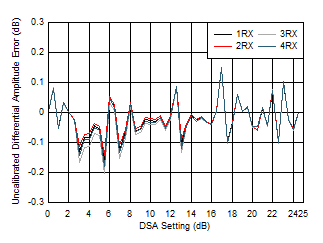
| With
2.6 GHz matching |
| Differential Amplitude Error = PIN(DSA
Setting – 1) – PIN(DSA Setting) + 1 |
Figure 6-351 RX
Uncalibrated Differential Amplitude Error vs DSA Setting at 2.6 GHz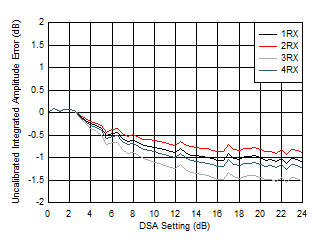
| With
2.6 GHz matching |
| Integrated Amplitude Error = PIN(DSA
Setting) – PIN(DSA Setting = 0) + (DSA
Setting) |
Figure 6-353 RX
Uncalibrated Integrated Amplitude Error vs DSA Setting at 2.6 GHz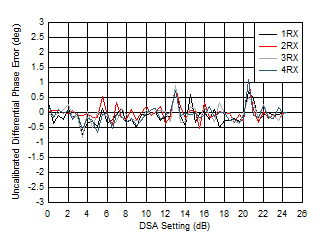
| With
2.6 GHz matching |
| Differential Phase Error = PhaseIN(DSA
Setting – 1) – PhaseIN(DSA Setting) |
Figure 6-355 RX
Uncalibrated Differential Phase Error vs DSA Setting at 2.6 GHz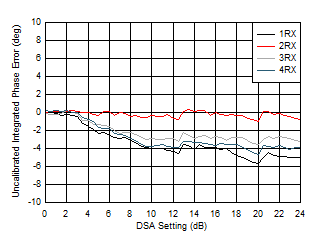
| With
2.6 GHz matching |
| Integrated Phase Error = Phase(DSA Setting) – Phase(DSA
Setting = 0) |
Figure 6-357 RX
Uncalibrated Integrated Phase Error vs DSA Setting at 2.6 GHz
| With
2.6 GHz matching, fIN = 2610 MHz,
AIN= –3 dBFS |
|
|
Figure 6-359 RX
Output FFT at 2.6 GHz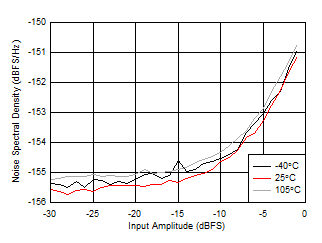
| With
2.6 GHz matching, DSA Setting = 12 dB, 12.5-MHz offset
from tone |
Figure 6-361 RX
Noise Spectral Density vs Input Amplitude and Temperature at 2.6 GHz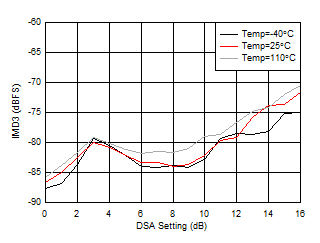
| With
2.6 GHz matching, each tone –7 dBFS, tone spacing = 20
MHz |
Figure 6-363 RX
IMD3 vs DSA Setting and Temperature at 2.6 GHz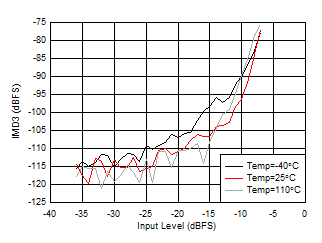
| With
2.6 GHz matching, tone spacing = 20 MHz, DSA = 12
dB |
Figure 6-365 RX
IMD3 vs Input Level and Temperature at 2.6 GHz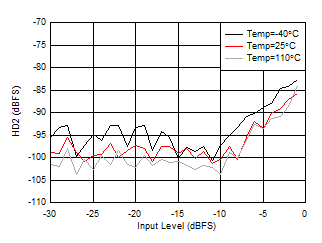
| With
2.6 GHz matching, DDC bypass mode (TI only mode for
characterization) |
Figure 6-367 RX
HD2 vs Input Level and Temperature at 2.6 GHz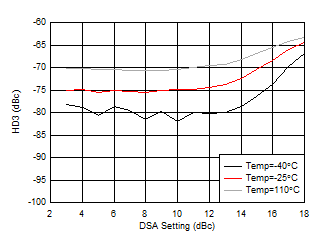
| With
2.6 GHz matching, DDC bypass mode (TI only mode for
characterization) |
Figure 6-369 RX
HD3 vs DSA Setting and Temperature at 2.6 GHz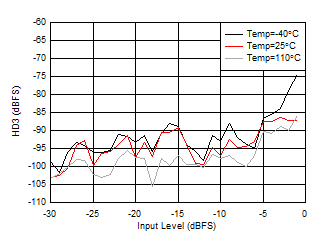
| With
2.6 GHz matching, DDC bypass mode (TI only mode for
characterization) |
Figure 6-371 RX
HD3 vs Input Level and Temperature at 2.6 GHz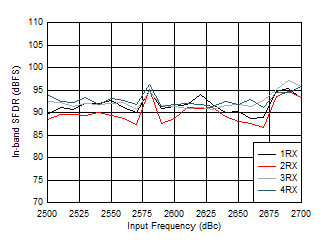 Figure 6-373 RX
In-Band SFDR (±200 MHz) vs Frequency With AIN= –6 dBFS at 2.6
GHz
Figure 6-373 RX
In-Band SFDR (±200 MHz) vs Frequency With AIN= –6 dBFS at 2.6
GHz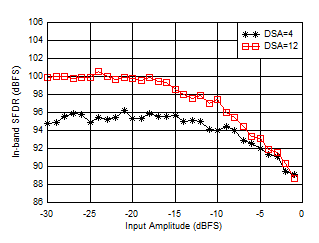 Figure 6-375 RX
In-Band SFDR (±200 MHz) vs Input Amplitude at 2.6 GHz
Figure 6-375 RX
In-Band SFDR (±200 MHz) vs Input Amplitude at 2.6 GHz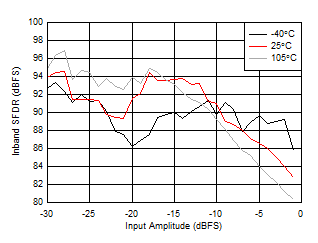
| With
2.6 GHz matching, decimate by 8, DSA Setting = 12
dB |
|
Figure 6-377 RX
Inband SFDR (±150 MHz) vs Input Amplitude and Temperature at 2.6 GHz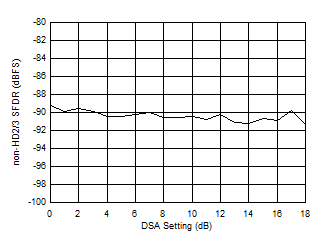 Figure 6-379 RX
Non-HD2/3 vs DSA Setting at 2.6 GHz
Figure 6-379 RX
Non-HD2/3 vs DSA Setting at 2.6 GHz
| With
2.6 GHz matching, 12.5-MHz offset, all supplies at MIN,
TYP, or MAX recommended operating voltages |
|
Figure 6-381 RX
Noise Spectral Density vs Supply and Channel at 2.6 GHz 
































